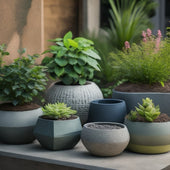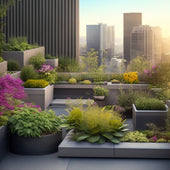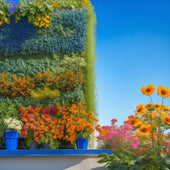
7 Essential Tips for Rooftop Garden Irrigation Controllers
Share
When designing your rooftop garden's irrigation system, start by choosing the right controller, evaluating garden size, plant types, and local climate. Consider smart controllers for large gardens, timer-based for small ones, and sensor-based for adjusting watering based on moisture levels. Understand your rooftop garden's needs, gauging soil moisture levels and adjusting irrigation schedules accordingly. Schedule watering sessions based on soil type, plant species, and climate zone, and automate irrigation cycles for consistent watering. By following these essential tips, you'll be well on your way to optimizing water usage and plant health, and taking your rooftop garden to the next level.
Key Takeaways
• Choose the right irrigation controller based on garden size, plant types, and local climate to ensure optimal watering.
• Regularly check and update the controller's software, inspect and clean sensors, and verify irrigation schedules to prevent errors.
• Assess soil moisture levels to determine watering frequency and amount, and adjust schedules based on soil type and plant needs.
• Schedule watering sessions based on climate zone, sunlight exposure, and plant requirements, with optimal timing in the morning or evening.
• Monitor rainfall and adjust irrigation schedules seasonally to reflect changing climate demands and prevent overwatering or underwatering.
Choosing the Right Controller
Selecting the right irrigation controller for your rooftop garden involves evaluating factors such as the size of your garden, the type of plants you're growing, and the local climate. You'll want to choose a controller that can handle the specific needs of your rooftop garden.
There are several controller types to evaluate, including smart controllers, timer-based controllers, and sensor-based controllers. Smart controllers are ideal for large gardens and can be controlled remotely, while timer-based controllers are better suited for smaller gardens. Sensor-based controllers adjust watering schedules based on soil moisture levels.
When selecting a controller, you'll also need to evaluate budget considerations. Controllers can range in price from under $100 to over $1,000, depending on the features and functionality. You'll need to balance your budget with the needs of your rooftop garden.
Look for controllers with features such as rain delay, multiple zone control, and water budgeting to guarantee you're getting the most value for your money. By evaluating these factors, you can choose a controller that meets the unique needs of your rooftop garden, guaranteeing your plants receive the right amount of water while also staying within your budget.
Understanding Rooftop Garden Needs
When designing an irrigation system for your rooftop garden, you need to evaluate the unique conditions of your space.
You'll want to assess the soil moisture levels, as they'll impact how often and how much water your plants require.
Soil Moisture Levels Matter
As you design your rooftop garden's irrigation system, monitoring soil moisture levels becomes essential to guarantee your plants receive the right amount of water. Overwatering can be detrimental to plant health, while underwatering can lead to drought stress. To avoid these issues, it's vital to understand the unique needs of your rooftop garden.
Here are some key considerations to keep in mind:
-
Soil type: Different soils have varying levels of moisture retention. Sandy soils drain quickly, while clay soils retain moisture longer. Choose an irrigation controller that accounts for your soil type.
-
Soil moisture sensors: Install sensors to measure soil moisture levels in real-time. This data will help your irrigation controller adjust watering schedules accordingly.
-
Moisture retention: Consider adding organic matter like compost to improve soil structure and moisture retention.
- Watering frequency: Adjust your irrigation schedule based on soil moisture levels. Water plants when the soil reaches a certain level of dryness, rather than on a fixed schedule.
Climate and Sun Exposure
You must consider the rooftop garden's exposure to climate and sunlight, which greatly impacts the watering schedule and overall plant health.
As you design your irrigation system, it's important to take into account the amount of sunlight your plants receive daily. South-facing gardens, for instance, receive more direct sunlight than north-facing ones, affecting evapotranspiration rates.
You should also identify your rooftop garden's climate zone, which influences temperature, humidity, and precipitation patterns. Knowing your climate zone helps you determine the best watering frequency and duration. In hot and dry climates, plants may require more frequent watering, while in cool and humid climates, they may need less.
To guarantee the best plant health, it's vital to adjust your irrigation schedule according to your rooftop garden's specific sunlight exposure and climate zone. By doing so, you'll provide your plants with the right amount of water, reducing the risk of overwatering or underwatering.
This attention to detail will result in a thriving rooftop garden that's safe and sustainable.
Scheduling Watering Sessions
When scheduling watering sessions for your rooftop garden, you'll need to decide on the frequency of waterings, taking into account factors like soil type and plant species.
You'll also want to determine the ideal time of day for watering, considering aspects like evaporation rates and sunlight exposure.
Additionally, you should adjust your schedule seasonally to accommodate changes in temperature and rainfall.
Watering Frequency Options
Rooftop garden irrigation controllers offer various watering frequency options, allowing you to schedule watering sessions daily, every other day, or at intervals of up to several days. This flexibility guarantees your plants receive the right amount of water, reducing waste and preventing overwatering.
When setting up your timer settings, consider the following options:
-
Daily Watering: Ideal for drip irrigation systems, which provide a slow and steady supply of water to your plants.
-
Every Other Day: Suitable for plants that require less frequent watering, such as succulents or cacti.
-
Every 2-3 Days: A good option for plants that need moderate watering, like vegetables or flowers.
- Custom Intervals: Allows you to set a specific watering schedule based on your plants' unique needs.
Optimal Time of Day
Scheduling watering sessions during prime times of day can greatly impact the health and survival of your rooftop plants. You want to avoid watering during the hottest part of the day, typically between 11 am and 3 pm, when evaporation rates are highest. Instead, opt for morning watering sessions, typically between 5 am and 9 am, when the air is cooler and more humid. This allows the plants to absorb the water efficiently and reduces evaporation.
Additionally, consider evening irrigation, between 5 pm and 8 pm, when the plants are preparing for the night. This helps to replenish the soil moisture and reduces transpiration rates. By scheduling watering sessions during these ideal times, you'll reduce water waste, prevent overwatering, and create a healthier environment for your rooftop plants.
Remember to adjust your irrigation controller according to your specific climate, soil type, and plant species to achieve the best results. By doing so, you'll be able to provide your plants with the right amount of water at the right time, promoting healthy growth and development.
Seasonal Adjustment Needs
As the seasons change, your irrigation controller's programming needs to adapt to the shifting climate demands of your plants, ensuring you provide the right amount of water to thrive. You'll need to adjust your controller's scheduling to accommodate the varying water requirements of your plants throughout the year.
Here are some seasonal adjustments to reflect upon:
-
Winter adjustments: Reduce watering frequency and duration to prevent overwatering, as plants require less moisture during the cold months.
-
Summer strategies: Increase watering frequency and duration to compensate for evapotranspiration and high temperatures.
-
Spring and fall adjustments: Gradually increase or decrease watering schedules as plants shift between seasons.
- Rainfall monitoring: Adjust your irrigation schedule based on rainfall data to avoid overwatering and conserve water.
Automating Irrigation Cycles
You can program your irrigation controller to automate irrigation cycles, guaranteeing your rooftop garden receives the right amount of water at the right time. This is especially important for rooftop gardens, where overwatering can lead to waterlogged soil and structural damage. By automating irrigation cycles, you can rest assured that your plants are receiving the right amount of water, without overwatering or underwatering.
To automate irrigation cycles, you'll need to set up a schedule based on factors like weather, soil type, and plant species. You can also integrate smart sensors that monitor weather conditions and adjust irrigation cycles accordingly. For instance, if it's been raining, the sensors can signal the controller to skip an irrigation cycle.
Drip systems, which deliver water directly to the roots, can also be automated to guarantee efficient watering. When programming your controller, be sure to set multiple start times to accommodate different plant species and areas of your rooftop garden.
With automated irrigation cycles, you can enjoy a lush, thriving rooftop garden while minimizing water waste and guaranteeing safety.
Monitoring Soil Moisture Levels
How accurately can your rooftop garden's soil moisture levels be monitored to guarantee ideal watering and prevent waterlogged soil or drought? You want to make sure your plants receive the right amount of water, and that's where soil moisture sensors come in. These sensors measure the moisture levels in the soil, providing you with valuable insights to optimize your irrigation schedule.
Here are some key considerations when monitoring soil moisture levels:
-
Soil type: Different soils have varying moisture retention capabilities. Understanding your soil type helps you adjust your irrigation schedule accordingly.
-
Sensor placement: Strategically place soil moisture sensors in areas that represent the overall soil moisture levels in your rooftop garden.
-
Moisture threshold: Set a moisture threshold that triggers irrigation when the soil reaches a certain level of dryness.
- Real-time monitoring: Use real-time monitoring to adjust your irrigation schedule based on changing soil moisture levels.
Dealing With Weather Extremes
Weather extremes, such as intense storms or prolonged droughts, can greatly impact your rooftop garden's irrigation needs. This makes it vital to integrate weather data into your irrigation controller's decision-making process. You'll want to guarantee your controller can adjust irrigation schedules based on real-time weather data to prevent overwatering during heavy rainfall or underwatering during droughts. This is essential for maintaining drought resilience and freeze protection in your rooftop garden.
To achieve this, consider installing weather sensors that can detect changes in temperature, humidity, and precipitation. These sensors can transmit data to your irrigation controller, allowing it to make informed decisions about when to water and how much.
Additionally, look for controllers with built-in weather algorithms that can analyze historical climate data and adjust irrigation schedules accordingly. By integrating weather data into your irrigation controller, you'll be able to create a more efficient and responsive irrigation system that adapts to changing weather conditions, guaranteeing your rooftop garden remains healthy and thriving.
Maintaining Controller Efficiency
Regular software updates and routine maintenance are essential to guaranteeing your rooftop garden's irrigation controller remains efficient and accurate in its watering decisions. By doing so, you'll prevent errors, reduce water waste, and guarantee your plants receive the right amount of water.
Here are some key maintenance tasks to perform:
-
Check and update your controller's software: Regularly check the manufacturer's website for controller upgrades and install them promptly to guarantee you have the latest features and bug fixes.
-
Inspect and clean sensors: Dirt, debris, or corrosion on sensors can lead to inaccurate readings. Clean or replace them as needed to guarantee accurate data.
-
Verify irrigation schedules: Double-check your irrigation schedules to guarantee they align with changing weather patterns and plant growth.
- Perform routine troubleshooting: Familiarize yourself with troubleshooting tips to quickly identify and resolve issues, such as faulty valves or clogged nozzles, to prevent water waste and plant damage.
Frequently Asked Questions
Can I Use a Smart Controller With My Existing Irrigation System?
You can upgrade your existing irrigation system with a smart controller, leveraging smart technology to optimize irrigation efficiency, but guarantee compatibility and safety by consulting the manufacturer's guidelines and performing a thorough system assessment.
How Often Should I Update My Controller's Software and Firmware?
You should regularly check for software maintenance alerts and perform firmware updates every 2-3 months to guarantee your controller remains secure, efficient, and compatible with your rooftop garden's evolving needs.
Are Rooftop Garden Irrigation Controllers Compatible With Solar Panels?
You're wondering if rooftop garden irrigation controllers can harness solar power, and the answer is yes, many modern controllers are designed for seamless solar panel compatibility, ensuring efficient irrigation system integration while prioritizing energy savings and safety.
Can I Control My Irrigation System Remotely Using a Mobile App?
You can control your irrigation system remotely using a mobile app, enjoying features like scheduling, real-time monitoring, and customizable alerts, which provide benefits like increased efficiency, reduced water waste, and peace of mind.
Are There Any Specific Certifications for Rooftop Garden Irrigation Controllers?
When selecting a rooftop garden irrigation controller, you'll want to look for certifications like UL (Underwriters Laboratories) or ETL (Intertek) marks, ensuring the controller meets strict safety standards and certification requirements for reliable, safe operation.
Related Posts
-

5 Best DIY Planter Ideas to Upcycle Concrete
You're about to breathe new life into discarded concrete blocks by transforming them into functional and visually app...
-

5 Best DIY Planter Ideas to Upcycle Concrete
You're about to breathe new life into discarded concrete blocks by transforming them into functional and visually app...
-

5 Best DIY Planter Ideas to Upcycle Concrete
You're about to breathe new life into discarded concrete blocks by transforming them into functional and visually app...
-

5 Best DIY Planter Ideas to Upcycle Concrete
You're about to breathe new life into discarded concrete blocks by transforming them into functional and visually app...
-

5 Best DIY Planter Ideas to Upcycle Concrete
You're about to breathe new life into discarded concrete blocks by transforming them into functional and visually app...
-

5 Best DIY Planter Ideas to Upcycle Concrete
You're about to breathe new life into discarded concrete blocks by transforming them into functional and visually app...
-

5 Best DIY Planter Ideas to Upcycle Concrete
You're about to breathe new life into discarded concrete blocks by transforming them into functional and visually app...
-

5 Best DIY Planter Ideas to Upcycle Concrete
You're about to breathe new life into discarded concrete blocks by transforming them into functional and visually app...
-

5 Best DIY Planter Ideas to Upcycle Concrete
You're about to breathe new life into discarded concrete blocks by transforming them into functional and visually app...
-

5 Best DIY Planter Ideas to Upcycle Concrete
You're about to breathe new life into discarded concrete blocks by transforming them into functional and visually app...
-

5 Best DIY Planter Ideas to Upcycle Concrete
You're about to breathe new life into discarded concrete blocks by transforming them into functional and visually app...
-

5 Best DIY Planter Ideas to Upcycle Concrete
You're about to breathe new life into discarded concrete blocks by transforming them into functional and visually app...
-

5 Best DIY Planter Ideas to Upcycle Concrete
You're about to breathe new life into discarded concrete blocks by transforming them into functional and visually app...
-

5 Best DIY Planter Ideas to Upcycle Concrete
You're about to breathe new life into discarded concrete blocks by transforming them into functional and visually app...
-

5 Best DIY Planter Ideas to Upcycle Concrete
You're about to breathe new life into discarded concrete blocks by transforming them into functional and visually app...
-

5 Best DIY Planter Ideas to Upcycle Concrete
You're about to breathe new life into discarded concrete blocks by transforming them into functional and visually app...
-

5 Best DIY Planter Ideas to Upcycle Concrete
You're about to breathe new life into discarded concrete blocks by transforming them into functional and visually app...
-

5 Best DIY Planter Ideas to Upcycle Concrete
You're about to breathe new life into discarded concrete blocks by transforming them into functional and visually app...
-

Irrigation System Design Ideas for Concrete Planters
As you design an irrigation system for your concrete planters, you'll need to balance drainage, moisture retention, a...
-

Irrigation System Design Ideas for Concrete Planters
As you design an irrigation system for your concrete planters, you'll need to balance drainage, moisture retention, a...
-

Irrigation System Design Ideas for Concrete Planters
As you design an irrigation system for your concrete planters, you'll need to balance drainage, moisture retention, a...
-

Irrigation System Design Ideas for Concrete Planters
As you design an irrigation system for your concrete planters, you'll need to balance drainage, moisture retention, a...
-

Irrigation System Design Ideas for Concrete Planters
As you design an irrigation system for your concrete planters, you'll need to balance drainage, moisture retention, a...
-

Irrigation System Design Ideas for Concrete Planters
As you design an irrigation system for your concrete planters, you'll need to balance drainage, moisture retention, a...
-

Irrigation System Design Ideas for Concrete Planters
As you design an irrigation system for your concrete planters, you'll need to balance drainage, moisture retention, a...
-

Irrigation System Design Ideas for Concrete Planters
As you design an irrigation system for your concrete planters, you'll need to balance drainage, moisture retention, a...
-

Irrigation System Design Ideas for Concrete Planters
As you design an irrigation system for your concrete planters, you'll need to balance drainage, moisture retention, a...
-

Irrigation System Design Ideas for Concrete Planters
As you design an irrigation system for your concrete planters, you'll need to balance drainage, moisture retention, a...
-

Irrigation System Design Ideas for Concrete Planters
As you design an irrigation system for your concrete planters, you'll need to balance drainage, moisture retention, a...
-

Irrigation System Design Ideas for Concrete Planters
As you design an irrigation system for your concrete planters, you'll need to balance drainage, moisture retention, a...
-

Irrigation System Design Ideas for Concrete Planters
As you design an irrigation system for your concrete planters, you'll need to balance drainage, moisture retention, a...
-

Irrigation System Design Ideas for Concrete Planters
As you design an irrigation system for your concrete planters, you'll need to balance drainage, moisture retention, a...
-

Irrigation System Design Ideas for Concrete Planters
As you design an irrigation system for your concrete planters, you'll need to balance drainage, moisture retention, a...
-

Irrigation System Design Ideas for Concrete Planters
As you design an irrigation system for your concrete planters, you'll need to balance drainage, moisture retention, a...
-

Irrigation System Design Ideas for Concrete Planters
As you design an irrigation system for your concrete planters, you'll need to balance drainage, moisture retention, a...
-

Irrigation System Design Ideas for Concrete Planters
As you design an irrigation system for your concrete planters, you'll need to balance drainage, moisture retention, a...
-

Irrigation System Design Ideas for Concrete Planters
As you design an irrigation system for your concrete planters, you'll need to balance drainage, moisture retention, a...
-

Irrigation System Design Ideas for Concrete Planters
As you design an irrigation system for your concrete planters, you'll need to balance drainage, moisture retention, a...
-

Irrigation System Design Ideas for Concrete Planters
As you design an irrigation system for your concrete planters, you'll need to balance drainage, moisture retention, a...
-

Irrigation System Design Ideas for Concrete Planters
As you design an irrigation system for your concrete planters, you'll need to balance drainage, moisture retention, a...
-

Irrigation System Design Ideas for Concrete Planters
As you design an irrigation system for your concrete planters, you'll need to balance drainage, moisture retention, a...
-

Irrigation System Design Ideas for Concrete Planters
As you design an irrigation system for your concrete planters, you'll need to balance drainage, moisture retention, a...
-

Irrigation System Design Ideas for Concrete Planters
As you design an irrigation system for your concrete planters, you'll need to balance drainage, moisture retention, a...
-

Irrigation System Design Ideas for Concrete Planters
As you design an irrigation system for your concrete planters, you'll need to balance drainage, moisture retention, a...
-

Irrigation System Design Ideas for Concrete Planters
As you design an irrigation system for your concrete planters, you'll need to balance drainage, moisture retention, a...
-

Irrigation System Design Ideas for Concrete Planters
As you design an irrigation system for your concrete planters, you'll need to balance drainage, moisture retention, a...
-

Irrigation System Design Ideas for Concrete Planters
As you design an irrigation system for your concrete planters, you'll need to balance drainage, moisture retention, a...
-

Irrigation System Design Ideas for Concrete Planters
As you design an irrigation system for your concrete planters, you'll need to balance drainage, moisture retention, a...
-

Irrigation System Design Ideas for Concrete Planters
As you design an irrigation system for your concrete planters, you'll need to balance drainage, moisture retention, a...
-

5 Tips for Thriving Vertical Vegetable Gardens
To thrive in vertical vegetable gardening, you'll want to choose a planter that meets the unique needs of your veggie...
-

5 Tips for Thriving Vertical Vegetable Gardens
To thrive in vertical vegetable gardening, you'll want to choose a planter that meets the unique needs of your veggie...
-

5 Tips for Thriving Vertical Vegetable Gardens
To thrive in vertical vegetable gardening, you'll want to choose a planter that meets the unique needs of your veggie...
-

5 Tips for Thriving Vertical Vegetable Gardens
To thrive in vertical vegetable gardening, you'll want to choose a planter that meets the unique needs of your veggie...
-

5 Tips for Thriving Vertical Vegetable Gardens
To thrive in vertical vegetable gardening, you'll want to choose a planter that meets the unique needs of your veggie...
-

5 Tips for Thriving Vertical Vegetable Gardens
To thrive in vertical vegetable gardening, you'll want to choose a planter that meets the unique needs of your veggie...
-

5 Tips for Thriving Vertical Vegetable Gardens
To thrive in vertical vegetable gardening, you'll want to choose a planter that meets the unique needs of your veggie...
-

5 Tips for Thriving Vertical Vegetable Gardens
To thrive in vertical vegetable gardening, you'll want to choose a planter that meets the unique needs of your veggie...
-

5 Tips for Thriving Vertical Vegetable Gardens
To thrive in vertical vegetable gardening, you'll want to choose a planter that meets the unique needs of your veggie...
-

5 Tips for Thriving Vertical Vegetable Gardens
To thrive in vertical vegetable gardening, you'll want to choose a planter that meets the unique needs of your veggie...
-

5 Tips for Thriving Vertical Vegetable Gardens
To thrive in vertical vegetable gardening, you'll want to choose a planter that meets the unique needs of your veggie...
-

5 Tips for Thriving Vertical Vegetable Gardens
To thrive in vertical vegetable gardening, you'll want to choose a planter that meets the unique needs of your veggie...
-

5 Tips for Thriving Vertical Vegetable Gardens
To thrive in vertical vegetable gardening, you'll want to choose a planter that meets the unique needs of your veggie...
-

5 Tips for Thriving Vertical Vegetable Gardens
To thrive in vertical vegetable gardening, you'll want to choose a planter that meets the unique needs of your veggie...
-

5 Tips for Thriving Vertical Vegetable Gardens
To thrive in vertical vegetable gardening, you'll want to choose a planter that meets the unique needs of your veggie...
-

5 Tips for Thriving Vertical Vegetable Gardens
To thrive in vertical vegetable gardening, you'll want to choose a planter that meets the unique needs of your veggie...
-

5 Tips for Thriving Vertical Vegetable Gardens
To thrive in vertical vegetable gardening, you'll want to choose a planter that meets the unique needs of your veggie...


